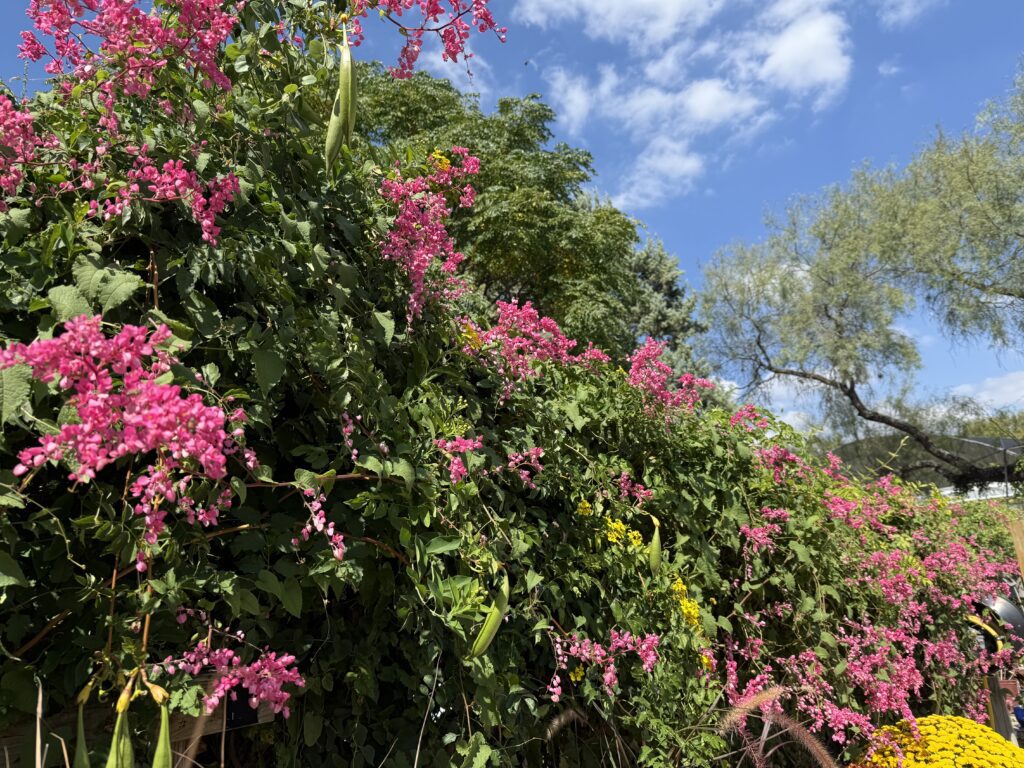If you’re looking to add late-season color and pollinator appeal to your garden in the San Antonio area, look no further than the stunning Antigonon leptopus, commonly known as coral vine (also “Queen’s Wreath” or “Queen’s Crown Vine”). In this blog we’ll dive into why coral vine is such a brilliant choice for South‐Texas landscapes, especially around San Antonio. We’ll discuss how to grow it, care for it, and best of all, how it actively supports our bees and pollinators when many other plants are slowing down.
Why Coral Vine in San Antonio is a Great Choice
Because San Antonio has hot summers and mild winters (with occasional freeze risk), you want plants that can thrive in heat and deliver impact later in the season. Coral vine fits that bill. It blooms summer into fall, providing a huge splash of color with long-lasting blooms when many plants have already peaked. According to several horticulture sources, it “blooms continuously from late summer until the first frost” and is prized for its ability to attract bees, butterflies, and hummingbirds.

Pollinator Power: Why Coral Vine is a Bee Magnet
One of the standout features of coral vine is how it invites pollinators into your yard; significantly so during the late season when nectar is scarcer. Here’s how it helps:
-
The showy flower clusters produce lots of nectar, which draws bees and butterflies alike. Just go take a look at the display coral vine at our Thousand Oaks location right now. It covers the length of the fence to the left of the back entrance and is always buzzing with bees. It’s a spectacular sight in fall!
-
It’s particularly useful as a late-season nectar source. Because many spring and summer bloomers wrap up early, a vine that continues into fall can mean the difference between pollinators having ample forage and facing scarcity. Bees will thank you. It’s a little blurry, but if you zoom in on the pic above, there are tons of bees on this plant.
-
Even the seeds and the foliage structure can support wildlife. Seed‐eating insects will search it out, as well as birds and other local wildlife seeking habitat and shelter.
For a San Antonio gardener, planting coral vine means you’re not just beautifying your yard — you’re actively feeding local pollinators and contributing to our supporting our local ecosystems.

How to Grow Coral Vine in San Antonio
Sun & Location:
Full sun is best for abundant blooms. Coral vine thrives in warm, sunny spots.
Offer support by considering using a trellis, fence, pergola, or arbor. It climbs vigorously with tendrils.
Soil & Water:
It will tolerate a range of soils (from sandy to loam), provided drainage is decent.
Once established, coral vine is fairly drought‐tolerant; a welcome attribute in the often dry South Texas climate.
Hardiness / Climate Considerations:
Although it is tropical by origin (native to Mexico and Central America), in San Antonio you may see some winter die‐back if we hit a hard freeze. However, it typically bounces back with warmer weather. A nice layer of mulch around the base of the plant (though not piled up onto the crown) through winter will help protect its roots.
Planting it in a location with some winter sun on the trellis also gives you better results.
Growth Habit & Pruning:
This vine can grow, ahem, ambitiously (some reports say up to 40 ft long and 20+ ft wide in ideal conditions), so give it plenty of space to stretch its lovely legs.
In cold winters, it will naturally die back, but if its a warm winter, you may want to prune it to the ground before spring growth develops. This will help keep the size in check.
Because of its, ahem, enthusiasm, plan your location with the “grown up” size in mind.
Design Ideas for San Antonio Yards
-
Use coral vine as a vertical accent: Cover an unsightly wall or fence with it, and the cascading pink blooms will soften and beautify the space.
-
Combine with other native or heat-tolerant pollinator plants for a “bee corridor” effect: e.g., place coral vine near lower shrubs and grasses that bloom earlier, so you provide nectar across seasons.
-
Let some blooms remain through fall — the bees will benefit, and the vine will provide aesthetic interest when many plants are slowing down.
By planting coral vine in your garden or landscape in the San Antonio region, you’re doing more than just growing a pretty vine — you’re creating a late-season nectar haven for bees, butterflies, and other pollinators. Wowee is this one a beauty!
~The Happy Gardener, Lisa Mulroy


Does coral vine work with yellow trumpet on the e same abhor and are they deer resistant?
Sure it would, they would most likely get somewhat tangles up together, but we actually have both on the same trellis at our Thousand Oaks location. Trumpet vine is considered deer resistant, but coral vine is not, although after deer eat at it, it does tend to regrow quickly, but no, not deer resistant.
I brought cuttings from a convent in Mexico, many years ago. Easily rooted and planted on a chain-link fence, shared with many friends – still beautiful every year. I cut it to the ground after 1st freeze, roll it up and put it in backyard for birds and critters – lots of new shoots in the Spring.
Love your website – have bought many-a-plant from you, back from Kathy’s era.
Oh wonderful! We love a success story! Thanks for sharing and for being a long time friend and customer of Rainbow Gardens!